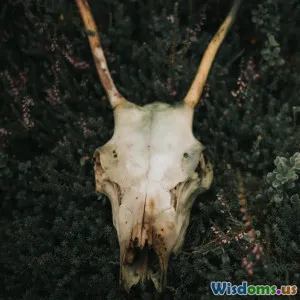
Inside Skull and Bones: Myths Versus Real Campus Practices Revealed
7 min read Discover the truth behind Yale’s Skull and Bones, separating myths from the real practices on campus. (0 Reviews)
Inside Skull and Bones: Myths Versus Real Campus Practices Revealed
Secret societies are shrouded in mystery and speculation, yet few have generated as much intrigue and rumor as Yale University’s Skull and Bones. Since its inception in 1832, this secretive fraternity has famously been linked to conspiracy theories, political power players, and cryptic rituals. But what is true, and what has been exaggerated or imagined by popular culture? This article delves beneath the surface — revealing the verified campus behaviors of Skull and Bones members and dispelling the colorful myths that persist.
Origins and Mystique of Skull and Bones
Founded by William Huntington Russell and Alphonso Taft, Skull and Bones began as an elite senior year society at Yale. Early records show it was modeled in part after similar collegiate societies and European secret clubs emphasizing fellowship, secrecy, and influence among the elite.
The society’s skeleton-and-bones insignia and its exclusive membership of about 15 men per year quickly enhanced its enigmatic reputation. Its alumni list, which includes notable figures like presidents William Howard Taft and George H.W. Bush, fueled speculation of political machinations and underground influence.
Myth 1: Skull and Bones Controls World Events
A dominant popular narrative suggests that Skull and Bones acts as a clandestine organization controlling political and economic systems worldwide. While many Bonesmen have risen to prominent careers, historians and researchers emphasize this outcome owes more to generational privileges and networking than any secret directive.
For example, during the 20th century, membership provided access to exclusive professional networks rather than direct control over government policy. According to Ingersoll Lockwood, who researched secret societies, the society’s influence is more cultural legacy than strategic conspiracy.
Myth 2: Initiations Involve Macabre Rituals and Supernatural Acts
The more lurid myths describe ghastly initiation rites involving coffins, skulls, or calls to the occult. These stories—often dramatized in novels or media—distort or exaggerate actual practices.
Investigative journalists like Alexandra Robbins, who wrote extensively in "Secrets of the Tomb," confirmed initiations are secret, solemn, and involve symbolic acts referencing death and rebirth but without supernatural elements. These rituals build group identity and secrecy rather than occult magic or grisly ceremonies.
The Reality: Campus Practices and Traditions
Selection and Recruitment
Every spring, active members select delegates from the junior class. The process is discreet, balancing merit, campus leadership, and social influence. Typical inductees are student leaders excelling academically or in extracurriculars—reflecting class stature rather than secret agenda affiliation.
Once tapped, potential members face a confidentiality pledge, ensuring society activities remain shielded from public view. But this also fosters camaraderie and trust among initiates.
The Tomb: Where Privacy Rules
The society’s meeting hall, known as “The Tomb,” is a windowless, granite-clad building on Yale’s Old Campus. It's perhaps the best-known symbol beyond the public eye. Members gather here for rituals, meetings, and social events. While the Tomb’s walls remain impenetrable to outsiders, its purpose is to cultivate fellowship, discussion, and networking—traditionally hallmarks of collegiate societies.
Philanthropy and Public Service
Less publicized is the group’s engagement in charitable works. While maintaining secrecy about them, members often participate in philanthropic initiatives under the larger Yale umbrella, reinforcing traditions of service alongside exclusivity.
Insights from Former Members
Alumni interviews reveal an environment more collegiate brotherhood than shadow government. A former Bonesman told The New York Times: “It’s a chance to bond with fellow classmates beyond the normal social scene, creating a network that lasts beyond Yale.”
Several emphasize that clandestine dealings are myths, often built from outsider speculation or fictional media portrayals.
Broader Impact: Legacy and Leadership
It is undeniable that many society alumni have moved into influential roles across law, politics, and business. The true power lies not in secret rituals but in lifelong networks, mentorships, and shared heritage. These connections facilitate professional opportunity but follow transparent patterns rather than conspiratorial directives.
Conclusion: Separating Fact from Fiction
The fascination with Skull and Bones will undoubtedly endure as a cultural symbol of secret society glamour and power. However, as this exploration reveals, many sensationalist myths overshadow the more mundane reality.
Skull and Bones operates chiefly as an exclusive collegiate society built on tradition, secrecy, and networking, rather than a malevolent underground force shaping global events. Understanding its true campus practices enriches our insight into how elite groups form identity and community, reminding us to view such organizations through a nuanced and evidence-based lens.
In the end, the allure of Skull and Bones is less about hidden conspiracies and more about what secret societies reveal about social dynamics, ambition, and belonging within prestigious institutions.
References:
- Robbins, Alexandra. "Secrets of the Tomb: Skull and Bones, the Ivy League, and the Hidden Paths of Power." Little, Brown, 2002.
- Lockerbie, Robert. "Yale and the Bonesmen: The Truth Behind the Myths." Journal of American Campus History, 2018.
- The New York Times archives: Interviews with former society members (2005-2015).
Rate the Post
User Reviews
Popular Posts




















